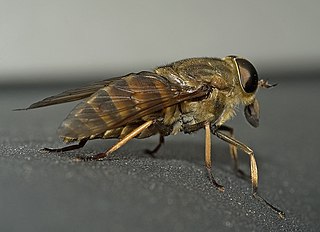
The Brachyceran infraorder Tabanomorpha is a small group that consists primarily of two large families, the Tabanidae and Rhagionidae, and an assortment of very small affiliated families, most of which have been included within the Rhagionidae.

The Brachyceran family Vermileonidae is a small family of uncertain affinities and unusual biology. It includes fewer than 80 described species, most of them rare and with restricted distribution, in 10 genera. Historically the vermileonids had been regarded as belonging to the family Rhagionidae, possibly in a subfamily Vermileoninae. Their biology and morphology are so markedly distinct from the main Rhagionidae sensu stricto however, that the placement as a separate family has been widely accepted.

The Chamaemyiidae are a small family of acalyptrate flies with less than 200 species described worldwide. The larvae of these small flies are active and predatory and are often used for biological control of aphids, scale insects, and similar pests. Chamaemyiid fossils are poorly represented in amber deposits, but a few examples are known from the Eocene epoch onwards.

Xylomyidae is a family of flies known commonly as the wood soldier flies. They are xylophagous and are associated with dead or dying wood.

Odiniidae is a small family of flies. There are only 58 described species but there are representatives in all the major biogeographic realms.

Rhagionidae or snipe flies are a small family of flies. They get their name from the similarity of their often prominent proboscis that looks like the beak of a snipe.

Hybotidae, the typical dance flies, are a family of true flies. They belong to the superfamily Empidoidea and were formerly included in the Empididae as a subfamily.

Rhagio is a worldwide genus of predatory snipe flies. Several species in this genus are referred to as downlooker or down-looker flies because they sometimes perch on tree trunks in a head-down position. There are approximately 170 species. They can be distinguished from other rhagionids by the open anal cell on the wings and the lack of a kidney-shaped arista.
Austroleptis is a genus of snipe flies, and the sole genus in the family Austroleptidae; until 2010, it was placed in the family Rhagionidae. They are small to moderately sized flies of around 3 to 7.7 mm.
Bolbomyia is a genus of snipe flies, and the sole genus in the family Bolbomyiidae; until 2010, it was placed in the family Rhagionidae. They are a small 2 to 3.5 mm, brown or black in color, with lightly infuscate (darkened) wings. They are restricted to the north temperate region of North America and Russian Far East (Kamchatka).
Alloleptis is a genus of snipe fly of the family Rhagionidae. It is a small fly of about 4 mm and only known from Sulawesi. It currently contains only one species, Alloleptis tersus.
Arthroceras is a genus of snipe fly of the family Rhagionidae. Arthroceras are mid-sized to large 4.5 to 13 millimetres, black, grey, or yellowish-colored flies that have a fairly long, tapering antenna consisting of 5–8 flagellomeres. Within Rhagonidae, the genus is sometimes(?) placed in the subfamily Arthrocerinae, in which it is the only genus.
Arthroteles is a genus of snipe fly of the family Rhagionidae. Species of Arthroteles are moderately sized, from 5 to 7.5 mm. They are gray to dark gray in colour. Their antenna bears seven to eight tapering flagellomeres, the first much larger than all others.
Atherimorpha is a genus of snipe fly of the family Rhagionidae.
Desmomyia is a genus of snipe flies of the family Rhagionidae. They have the antennal scape elongated, longer than the pedicel, and the male hind first tarsomere enlarged. Desmomyia are mid-sized flies of about 5 to 7 mm and of grey, black, or brownish colour and the legs have some yellow or dark brown to black.
Schizella is a genus of snipe flies of the family Rhagionidae. They are delicate flies from 3.7 to 6.3 mm, with long, thin legs, and the thorax is brown to orange-brown with blue, purple, or golden-coloured setae.
Stylospania is a genus of snipe flies of the family Rhagionidae. The genus is based on one single male specimen collected from Samar in the Philippines. It bears most of the features found in Chrysopilus, but with its stylate flagellum. The female of the genus is completely unknown. Stylospania lancifera is a delicate little fly of 4.5 mm.

Rhagioninae is a worldwide subfamily of predatory snipe flies.
Microphorella is a genus of flies in the family Dolichopodidae. It is currently considered both paraphyletic and polyphyletic, and several species groups may need to be recognised as subgenera or genera.







